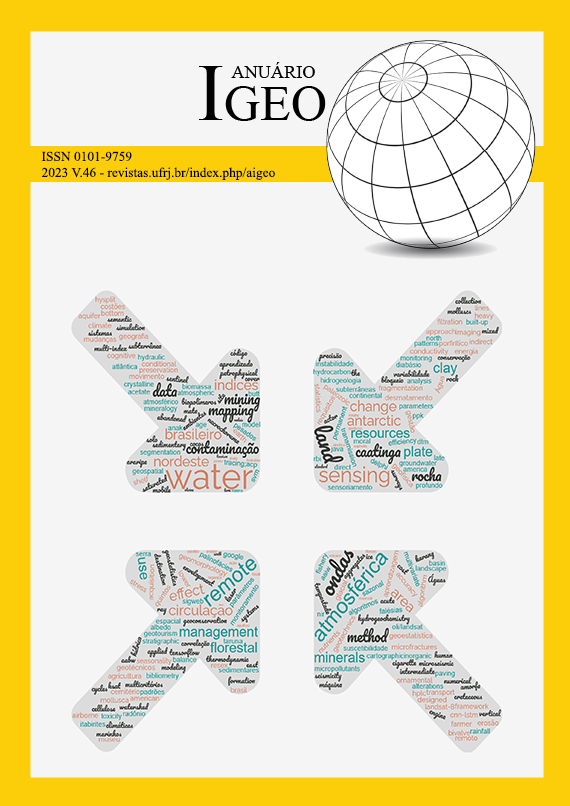A New Approach for Structural Monitoring Based on Terrestrial Laser Scan Data Using Control Planes
DOI:
https://doi.org/10.11137/1982-3908_2023_46_53598Keywords:
Point cloud, Least Squares Estimation, Terrestrial Laser ScannerAbstract
Laser scanning is a survey method that enables the obtaining of several data points on surfaces through the observation of horizontal and vertical angles and electronic distance measurements. The result of these observations is a set of 3D points named point clouds, which can be obtained from scans using total stations or the Terrestrial Laser Scanner (TLS). Currently, the use of TLS in geodetic structural deformation monitoring activities is under evaluation, since this technique can provide a greater number of points in a shorter period, when compared to scans performed by total stations. In this research, the feasibility of using control planes for geodetic monitoring was investigated in a controlled laboratory environment, exploring the current trend of parameterization of point clouds. From the development of an Experimental Plane Control (EPC) containing a flat surface that could be inclined in a controlled way, simultaneous scans with TLS and total station were carried out at different inclinations of the control plane. Both surveys were done in frontal scan mode (minimum plane inclination of 0º53’ and maximum plane inclination of 3º28’) and in oblique mode (plane inclination of 1º09’), where the plane inclination angles were generated by the rotation in EPC base, considering the first plane position as reference to inclination calculating. From parametrization of point clouds, a new approach was developed to test the significance of the estimated inclination angle of the plane in relation to a reference position. The results showed that it is possible to confirm that the inclined angles were statistically significant, but that the TLS scanning position can interfere in the determination of these data for monitoring purposes.
Downloads
References
Alves, S.S.O. 2020, 'Investigação laboratorial de uma abordagem estatística baseada em planos de controle aplicados ao monitoramento de estruturas com varredura laser terrestre', Master Thesis, Universidade Federal do Paraná, viewed 19 April 2018, <https://acervodigital.ufpr.br/handle/1884/66676>.
Aydin, C. 2012, 'Power of global test in deformation analysis', Journal of Surveying Engineering, vol. 138, no. 2, pp. 51-6, DOI:10.1061/(asce)su.1943-5428.0000064.
Barbarella, M., D’Amico, F., Blasiis, M.R., Benedetto, A. & Fiani, M. 2018, 'Use of terrestrial laser scanner for rigid airport pavement management', Sensors, vol. 18, no. 1, 44, DOI:10.3390/s18010044.
COPEL ‒ Companhia Paranaense de Energia 2018, Salto Caxias Hydroelectric Power Plant, viewed 19 April 2018, <http://www.copel.com/hpcopel/root/nivel2.jsp?endereco=%2Fhpcopel%2Froot%2Fpagcopel2.nsf%2Fdocs%2F62B5CF75B928C3D403257745004890B2>.
Erdélyi, J., Kopáčik, A., Lipták, I. & Kyrinovič, P. 2017, 'Automation of point cloud processing to increase the deformation monitoring accuracy', Applied Geomatics, vol. 9, no. 2, pp. 105-13, DOI:10.1007/s12518-017-0186-y.
Ghilani, C.D. 2018, Adjustment computations: Spatial data analysis, vol. 6, John Wiley & Sons Inc., New Jersey.
Holst, C. & Kuhlmann, H. 2016, 'Challenges and present fields of action at laser scanner based deformation analyses', Journal of Applied Geodesy, vol. 10, no. 1, pp. 17-25, DOI:10.1515/jag-2015-0025.
Jaafar, H.A., Meng, X. & Sowter, A. 2017, 'Terrestrial laser scanner error quantification for the purpose of monitoring', Survey Review, vol. 50, no. 360, pp. 232-48, DOI:10.1080/00396265.2016.1259721.
Klein, I., Matsuoka, M.T., Guzatto, M.P., Nievinski, F.G., Veronez, M.R. & Roffato, V.F. 2019, 'A new relationship between the quality criteria for geodetic networks', Journal of Geodesy, vol. 93, no. 4, pp. 529-44, DOI:10.1007/s00190-018-1181-8.
Leica Geosystems 2015, TS15 user manual, Leica, Suíça.
Leica Geosystems 2018, Leica BLK360: User manual, 2nd edn, Leica, Brazil.
Lindenbergh, R. & Pietrzyk, P. 2015, 'Change detection and deformation analysis using static and mobile laser scanning', Applied Geomatics, vol. 7, no. 2, pp. 65-74, DOI:10.1007/s12518-014-0151-y.
Lindenbergh, R.C. & Pfeifer, N. 2005, 'A statistical deformation analysis of two epochs of terrestrial laser data of a lock', Proceedings Conference on Optical, pp. 61-70, viewed 19 April 2018, <http://doris.tudelft.nl/~rlindenbergh/publications/O3DLindenberghPfeifer.pdf>.
Lovas, T., Barsi, A., Detrekői, Á., Dunai, L., Csak, Z., Polgar, A.A., Berenyi, A., Kibedy, Z. & Szőcs, K. 2008, 'Terrestrial laser scanning in deformation measurements of structures', International Archives of Photogrammetry, Remote Sensing and Spatial Information Sciences, pp. 527-32.
Monserrat, O. & Crosetto, M. 2008, 'Deformation measurement using terrestrial laser scanning data and least squares 3D surface matching', ISPRS Journal of Photogrammetry and Remote Sensing, vol. 63, no. 1, pp. 142-54, DOI:10.1016/j.isprsjprs.2007.07.008.
Ogundare, J.O. 2016, Precision surveying: The principles and geomatics practice, John Wiley & Sons Inc, Hoboken.
Osgood, W.F. & Graustein, W.C. 1921, Plane and solid analytic geometry, The Macmillan Company, New York.
Pavan, N.L., Santos, D.R. & Khoshelham, K. 2020, 'Global registration of terrestrial laser scanner point clouds using plane-to-plane correspondences', Remote Sensing, vol. 12, no. 7, 1127, DOI:10.3390/rs12071127.
Petrie, G. & Toth, C.K. 2018, Topographic laser ranging and scanning: Principles and processing, Taylor & Francis Group, Boca Raton.
Schneider, D. 2006, 'Terrestrial laser scanning for area-based deformation analysis of towers and water damns', paper presented to the IAG Symposium on Geodesy for Geotechnical and Structural Engineering 3 and FIG Symposium on Deformation Measurement, Baden.
Steinbruch, A. & Winterle, P. 1987, Geometria analítica, 2nd edn, Mcgraw-hill Artmed, São Paulo.
Teunissen, P.J.G. 2006, Testing theory: An introduction, 2nd edn, VSSD, Delft.
Vosselman, G. & Maas, H. 2010, Airborne and terrestrial laser scanning, 1st edn, Whittles Publishing, Dunbeath.
Walton, G., Delaloye, D. & Diederichs, M.S. 2014, 'Development of an elliptical fitting algorithm to improve change detection capabilities with applications for deformation monitoring in circular tunnels and shafts', Tunnelling and Underground Space Technology, vol. 43, no. 1, pp. 336-49, DOI:10.1016/j.tust.2014.05.014.
Downloads
Additional Files
Published
How to Cite
Issue
Section
License
This journal is licensed under a Creative Commons — Attribution 4.0 International — CC BY 4.0, which permits use, distribution and reproduction in any medium, provided the original work is properly cited.















